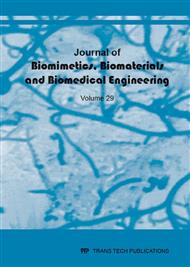[1]
Jager, E.; W. H.; Smela, E.; Inganäs O. Microfabricating conjugated polymer actuators. Science 290 (5496), 1540-1545(2000).
DOI: 10.1126/science.290.5496.1540
Google Scholar
[2]
Haes, A.J.; Zou, S.; Schatz, G.C.; Van Duyne, R. P. Nanoscale optical biosensor: short range distance dependence of the localized surface plasmon resonance of noble metal nanoparticles. J. Phys. Chem. B 108 (22), 6961-6968(2004).
DOI: 10.1021/jp036261n
Google Scholar
[3]
Ma, M.; Guo, L.; Anderson, D.G.; Langer, R. Bio-inspired polymer composite actuator and generator driven by water gradients. Science 339 (6116), 186-189(2013).
DOI: 10.1126/science.1230262
Google Scholar
[4]
Y.Q., Gu,; J.G., M et al. Characteristics on drag reduction of bionic jet surface based on earthworm's back orifice jet. Acta. Phys. Sin. 24701-024701(2015).
DOI: 10.7498/aps.64.024701
Google Scholar
[5]
Terasawa, N.; Takeuchi, I.; Matsumoto, H. Electrochemical properties and actuation mechanisms of actuators using carbon nanotube-ionic liquid gel. Sens. Actuators, B 139 (2), 624-630(2009).
DOI: 10.1016/j.snb.2009.03.057
Google Scholar
[6]
Mukai, K.; Asaka, K.; Kiyohara, K.; Sugino, T.; Takeuchi, I.; Fukushima, T.; Aida, T. High performance fully plastic actuator based on ionic-liquid-based bucky gel. Electrochimica. Acta 53 (17), 5555-5562(2008).
DOI: 10.1016/j.electacta.2008.02.113
Google Scholar
[7]
Hung, J.H.; Jeon, J.H., Sridhar, V., et al. Electro-active graphene–Nafion actuatorsJ. Carbon, 49(4): 1279-1289(2011).
DOI: 10.1016/j.carbon.2010.11.047
Google Scholar
[8]
Kim, J.; Wang, N.; Chen, Y.; Yun, G.Y. An electro-active paper actuator made with lithium chloride/cellulose films: effects of glycerol content and film thickness. Smart Mater. Struct. 16 (5), 1564(2007).
DOI: 10.1088/0964-1726/16/5/009
Google Scholar
[9]
Kim, J. Wang, N.; Chen, Y. Effect of chitosan and ions on actuation behavior of cellulose– chitosan laminated films as electro-active paper actuators. Cellulose, 14(5), 439-445(2007).
DOI: 10.1007/s10570-007-9134-z
Google Scholar
[10]
Yun, S.; Kim, J. A bending electro-active paper actuator made by mixing multi-walled carbon nanotubes and cellulose. Smart Mater. Struct. 16 (4), 1471(2007).
DOI: 10.1088/0964-1726/16/4/062
Google Scholar
[11]
Yun, S.; Chen, Y.; Nayak, J.N.; Kim, J. Effect of solvent mixture on properties and performance of electro-active paper made with regenerated cellulose. Sens. Actuators, B, 129 (2), 652-658(2008).
DOI: 10.1016/j.snb.2007.09.049
Google Scholar
[12]
Sun, Z.; Zhao, G.; Guo, H.; Xu, Y.; Yang, J. Investigation into the actuating properties of ionic polymer metal composites using various electrolytes. Ionics, 21 (6), 1577-1586(2015).
DOI: 10.1007/s11581-014-1346-2
Google Scholar


